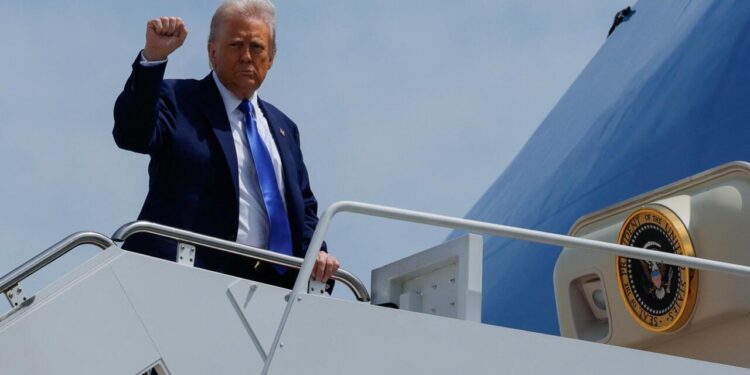In a significant diplomatic shift, President Trump is set to embark on a high-stakes trip to the Middle East, where he aims to bolster regional alliances and address long-standing geopolitical tensions. Key among his agenda items is a controversial plan to lift sanctions on Syria, a move that has drawn mixed reactions from lawmakers and analysts alike. As Trump prepares to tout lucrative deals struck with Saudi Arabia, including potential agreements in areas such as energy and defense, the implications for U.S. foreign policy and regional stability will be closely scrutinized. This trip marks a pivotal moment in the administration’s approach to the Middle East, with potential ramifications for both allies and adversaries in the complex landscape of the region.
Trumps Diplomatic Engagement in the Middle East: Analyzing the Implications of Sanction Relief in Syria
In a significant shift in U.S. foreign policy, President Trump is poised to lift sanctions on Syria, a move that could reshape diplomatic relations in the region. Analysts suggest that this decision is primarily aimed at facilitating constructive engagement with Syria and its allies, particularly in the context of an escalating humanitarian crisis. By relieving some economic pressure, the administration may intend to promote stability and encourage dialogue among stakeholders. This pivot toward sanction relief is also seen as a strategic play to strengthen partnerships with key Middle Eastern nations, predominantly Saudi Arabia, which has increasingly taken a proactive role in addressing regional conflicts.
As the Trump administration embarks on this diplomatic initiative, the implications of lifting sanctions cannot be understated. Critics highlight concerns regarding Iran’s influence in Syria and the potential for further destabilization if sanctions are removed without stringent conditions. On the other hand, proponents argue that engaging Damascus could lead to enhanced security cooperation and counterterrorism efforts. Key factors influencing this policy change include:
- Humanitarian Needs: The Syrian population faces dire conditions, and easing sanctions may facilitate much-needed aid.
- Regional Stability: Strengthening ties with Syria could help contain extremist groups operating in the area.
- U.S.-Saudi Relations: Closer alignment with Saudi Arabia may provide a counterbalance to Iranian dominance in the region.
| Factor | Impact |
|---|---|
| Sanction Relief | Potential economic growth and humanitarian assistance |
| Increased Diplomatic Ties | Strengthened alliances and improved negotiations |
| Security Concerns | Risk of escalating tensions with Iran and regional destabilization |
Economic Gains and Geopolitical Shifts: The Impact of Saudi Arabia Agreements on Regional Stability
The recent agreements forged by Saudi Arabia, particularly in the context of the Trump administration’s strategic maneuvers, are poised to significantly influence both economic conditions and geopolitical landscapes within the Middle East. With the lifting of sanctions on Syria becoming a pivotal part of the discussion, analysts are keenly observing how these shifts could enhance regional trade dynamics. Key economic benefits anticipated include:
- Increased investments in infrastructure projects across the Levant.
- Enhanced energy cooperation between Saudi Arabia and neighboring nations.
- Expansion of trade routes that could stabilize the economy in war-torn regions.
Furthermore, the realignment of alliances in the region is expected to provide a framework for greater stability. The agreements signal a potential thawing of relations not only between Saudi Arabia and its neighboring states but also with historical adversaries. This transformation could lead to diminished tensions and foster a collaborative environment for tackling shared challenges, such as security threats and economic instability. Below is a summary of potential impacts on geopolitical relations:
| Country | Expected Change in Relations | Long-Term Impact |
|---|---|---|
| Iran | Deterioration due to competitive interests | Increased regional insecurity |
| Israel | Strengthened ties through economic agreements | Enhanced security cooperation |
| Turkey | Potential for collaboration on energy projects | Economic interdependence |
Future Prospects: Strategic Recommendations for Sustaining Peace and Security in the Middle East
The recent announcement regarding the lifting of sanctions on Syria by the Trump administration heralds a pivotal shift in U.S. foreign policy towards the region. Such a move could facilitate enhanced dialogue and cooperation with Syria, which has been largely isolated on the international stage. To navigate this complex landscape, strategic recommendations include:
- Engaging with diverse stakeholders: Actively involve regional powers, civil society, and various factions within Syria to foster a more inclusive approach to rebuilding and stabilization efforts.
- Establishing a framework for dialogue: Create platforms for discussion that connect the U.S. with both adversaries and allies, building trust and reducing tensions in critical areas.
- Focusing on humanitarian aid and reconstruction: Allocate resources towards alleviating the humanitarian crisis in Syria, emphasizing the restoration of essential services and infrastructure.
In parallel, the recent deals brokered with Saudi Arabia provide an opportunity for broader strategic partnerships. To leverage these agreements for long-term stability, it is essential to:
- Promote economic interdependence: Foster trade agreements and investment opportunities that connect the economies of the Gulf states with those in the Levant, enhancing mutual interests.
- Strengthen security collaborations: Develop joint task forces that address regional security threats, including terrorism and arms proliferation, thereby solidifying U.S. alliances.
- Support educational and cultural initiatives: Invest in people-to-people programs that promote understanding and cooperation between U.S. and Middle Eastern youth.
To Conclude
President Trump’s upcoming trip to the Middle East highlights a significant shift in U.S. foreign policy, particularly regarding Syria and relations with key regional allies like Saudi Arabia. As he aims to lift sanctions that have long hindered reconstruction efforts in Syria, the administration is simultaneously touting the beneficial agreements forged with Saudi leaders. This delicate balancing act reflects a pragmatic approach to foster stability in a tumultuous region while navigating complex geopolitical dynamics. As the trip unfolds, the effectiveness of these initiatives in achieving lasting peace and prosperity in the Middle East will remain under scrutiny. Moving forward, the implications of these policy changes will be critical not only for U.S. relations with Middle Eastern nations but also for the broader international community’s efforts to stabilize one of the world’s most volatile areas.































